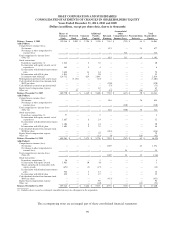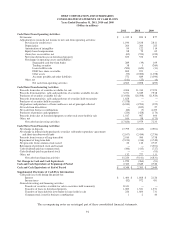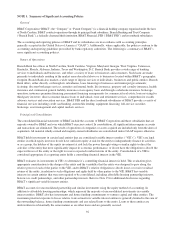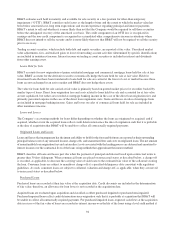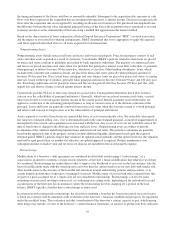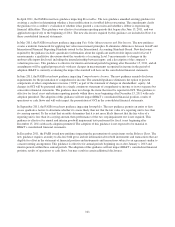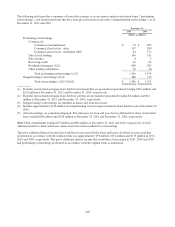BB&T 2011 Annual Report Download - page 100
Download and view the complete annual report
Please find page 100 of the 2011 BB&T annual report below. You can navigate through the pages in the report by either clicking on the pages listed below, or by using the keyword search tool below to find specific information within the annual report.Core deposit and other intangible assets include premiums paid for acquisitions of core deposits (“core deposit
intangibles”) and other identifiable intangible assets. Intangible assets other than goodwill, which are determined to have
finite lives, are amortized based upon the estimated economic benefits received.
Loan Securitizations
BB&T enters into loan securitization transactions related to most of its fixed-rate conforming mortgage loans. In
connection with these transactions, loans are converted into mortgage-backed securities issued primarily by the Federal
Home Loan Mortgage Corporation (“Freddie Mac”), the Federal National Mortgage Association (“Fannie Mae”) and the
Government National Mortgage Association (“Ginnie Mae”), and are subsequently sold to third party investors. BB&T
records loan securitizations as a sale when the transferred loans are legally isolated from its creditors and the other
accounting criteria for a sale are met. Gains or losses recorded on loan securitizations are based in part on the net carrying
amount of the loans sold, which is allocated between the loans sold and retained interests based on their relative fair
values at the date of sale. BB&T generally retains the mortgage servicing on loans sold. Since quoted market prices are
not typically available, BB&T estimates the fair value of these retained interests using modeling techniques to determine
the net present value of expected future cash flows. Such models incorporate management’s best estimates of key
variables, such as prepayment speeds and discount rates that would be used by market participants based on the risks
involved. Gains and losses incurred on loans sold to third party investors are included in mortgage banking income in the
Consolidated Statements of Income.
BB&T also periodically securitizes mortgage loans that it intends to hold for the foreseeable future and transfers the
resulting securities to the securities available for sale portfolio. This is generally accomplished by exchanging the loans
for mortgage-backed securities issued primarily by Freddie Mac. Since the transfers are not considered a sale, no gain or
loss is recorded in conjunction with these transactions.
Mortgage Servicing Rights
BB&T has two primary classes of mortgage servicing rights for which it separately manages the economic risks:
residential and commercial. Residential mortgage servicing rights are recorded on the Consolidated Balance Sheets
primarily at fair value with changes in fair value recorded as a component of mortgage banking income. Commercial
mortgage servicing rights are recorded as other assets on the Consolidated Balance Sheets at the lower of cost or market
and are amortized in proportion to, and over the estimated period, that net servicing income is expected to be received
based on projections of the amount and timing of estimated future net cash flows. The amount and timing of estimated
future net cash flows are updated based on actual results and updated projections. BB&T periodically evaluates its
commercial mortgage servicing rights for impairment.
Equity-Based Compensation
BB&T maintains various equity-based compensation plans. These plans provide for the granting of stock options
(incentive and nonqualified), stock appreciation rights, restricted stock, restricted stock units, performance units and
performance shares to selected BB&T employees and directors. BB&T values share-based awards at the grant date fair
value and recognizes the expense over the requisite service period taking into account retirement eligibility.
Changes in Accounting Principles and Effects of New Accounting Pronouncements
In February 2010, the Financial Accounting Standards Board (“FASB”) issued new guidance impacting Fair Value
Measurements and Disclosures. The new guidance requires a gross presentation of purchases and sales of Level 3
activities and adds a new requirement to disclose transfers in and out of Level 1 and Level 2 measurements. The guidance
related to the transfers between Level 1 and Level 2 measurements was effective for BB&T on January 1, 2010. The
guidance that requires increased disaggregation of the Level 3 activities was effective for BB&T on January 1, 2011. The
new disclosures required by this guidance are included in Note 18 to these consolidated financial statements.
In July 2010, the FASB issued new guidance impacting Receivables. The new guidance requires additional disclosures that will
allow users to understand the nature of credit risk inherent in a company’s loan portfolios, how that risk is analyzed and assessed
in arriving at the allowance for loan and lease losses, and changes and reasons for those changes in the allowance for loan and
lease losses. The new disclosures required by this guidance are included in Note 4 to these consolidated financial statements.
100


